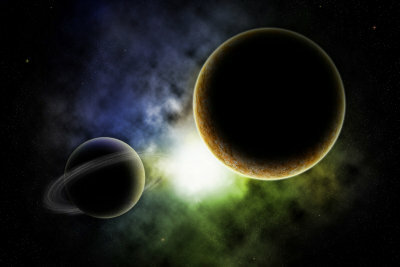Build a solar system model
Building a model of the solar system is not easy because of the enormous scale, but maybe you have some space in the garden for the model?

What you need:
- Balls made of wood, styrofoam or ceramic
- and of course a large garden
Building a solar system model is easy only at first glance. The problem is namely the enormous and, above all, different distances that the individual planets have from the sun. The designers of planetary paths must and had to solve this problem: the last planet (Pluto) in most models is more than 4 km away from the sun. Many models still represent the sizes of the planets to scale, but cheat on the distances. So if you have some space in your garden, you can build a model of the solar system. However, you will have to set up the planets on the outside of your neighbors - at least outside of your garden.
Representing the solar system - this is how it works in the garden
- First of all, you have to be clear about the size of the matter - after all, it is a question of distances that (can) be more than 400 m. Think about the direction of the solar system and where then Pluto will come.
- The following proposal is calculated on a scale of 1: 14 billion and gives both the size of the planets and their distance from the sun rounded, but correctly. Only the proportions of the sun and planets have been increased by a factor of 10, otherwise nobody will find your tiny planets. However, you should draw the viewer's attention to this problem with the model of the solar system.
- Place the sun and planets on smaller sticks, mark the path in the solar system with fluorescent pebbles or a ribbon.
- The diameter of the sun is 1 m. Perhaps you choose a styrofoam or plastic ball covered with gold foil and place it near your seat on the terrace. Appropriate lighting for the evening puts your solar system model in the right light.
- Even if a size factor of 10 is used for the planets, some of them are tiny in this model. Perhaps you choose small lights for the planets so that they are not overlooked.
- The planet Mercury is not only tiny (just over 3 millimeters); but also close to the sun. Its distance is a good 4 meters.
- For Venus and Earth, you can choose spheres of about 1 cm. The distance of Venus is almost 8 m, the earth is at a distance of a good 10 m from the sun.
- Mars is only half the size of the earth and is already 16 m away from the sun.
- Now there is a large distance in which the asteroid belt is located at a distance of almost 30 m. Perhaps you will mark it across your path.
- Jupiter is already about 55 m away from the Sun and its diameter is already 10 cm. After all, Jupiter is the largest of the planets.
- For the planet Saturn you need a sphere of almost 9 cm. It is located around 100 m from the sun. The rings of Saturn, which you can indicate with a ring around the planet, are particularly interesting.
- You may need to place Uranus with your neighbor. It is about 200 m away and has a diameter of almost 4 cm.
- In your model of the solar system, place Neptune (diameter almost 4 cm) at a distance of 320 m and the dwarf planet Pluto (diameter almost 2 mm) at a distance of 420 m. Chances are, these two solar system outposts are no longer on your property. But there can be a way.
Astronomy, special our solar system delights children. So why not a ...
Logarithmic scale of the model
- As the previous model showed, the vast differences in distance and size make one Model of the solar system big problems: the distances are huge, some planets are tiny in comparison to the sun.
- Alternatively, if you are a little mathematically versed, you can use a so-called logarithmic scale for the distances between the planets. To do this, calculate the individual distances with the calculator into logarithmic values and use these calculations to build the model. But then of course the impression of the really huge dimensions is lost.
How helpful do you find this article?

